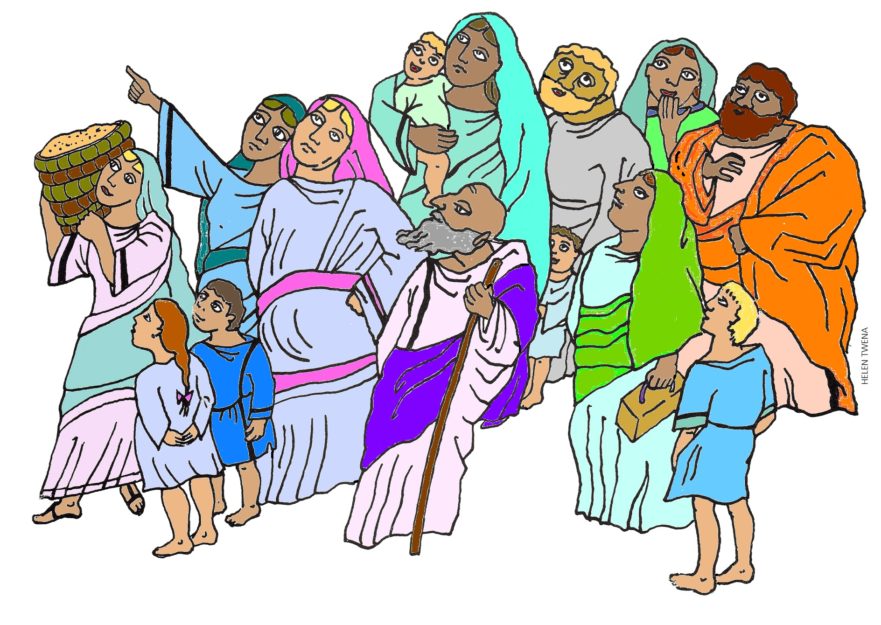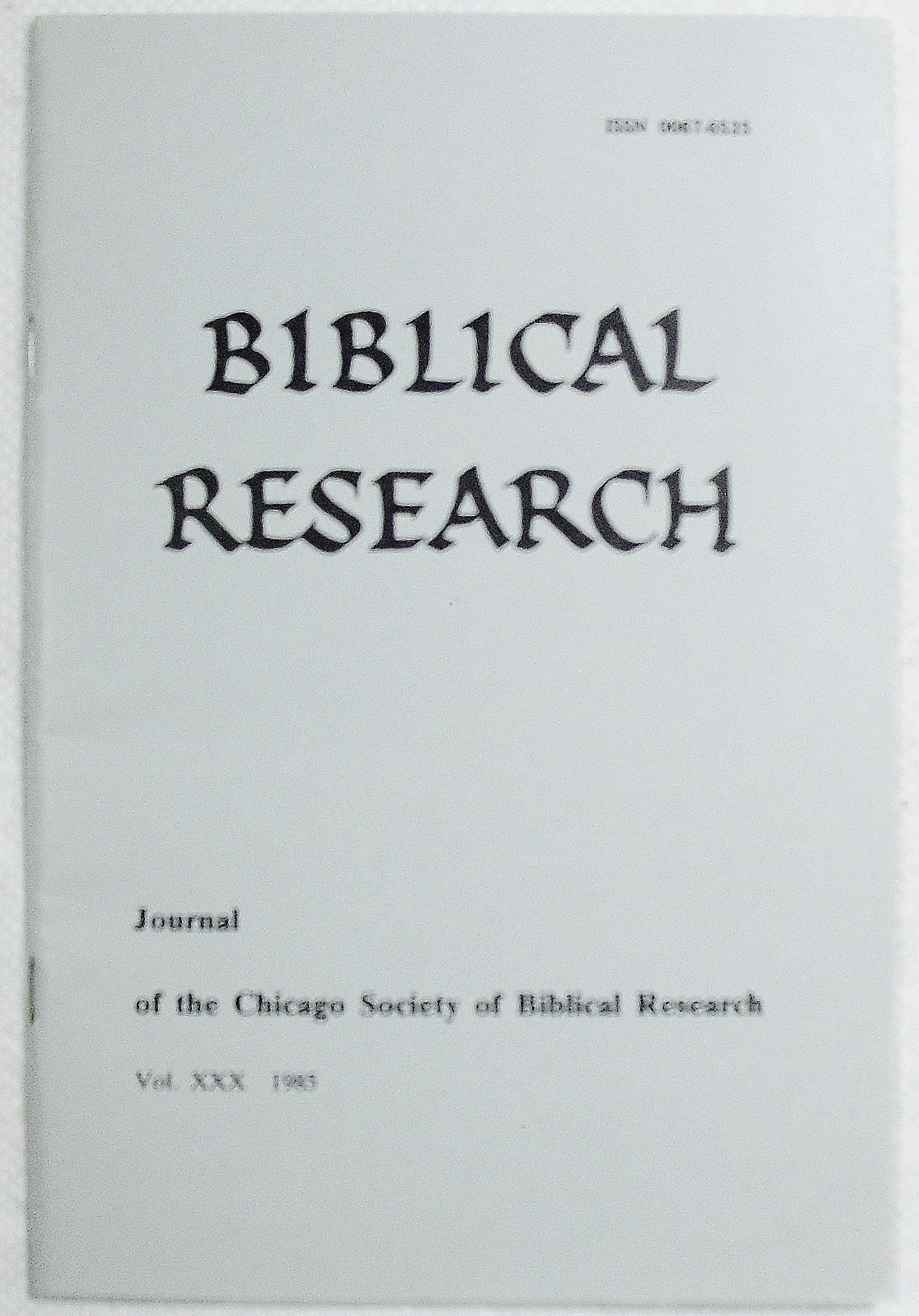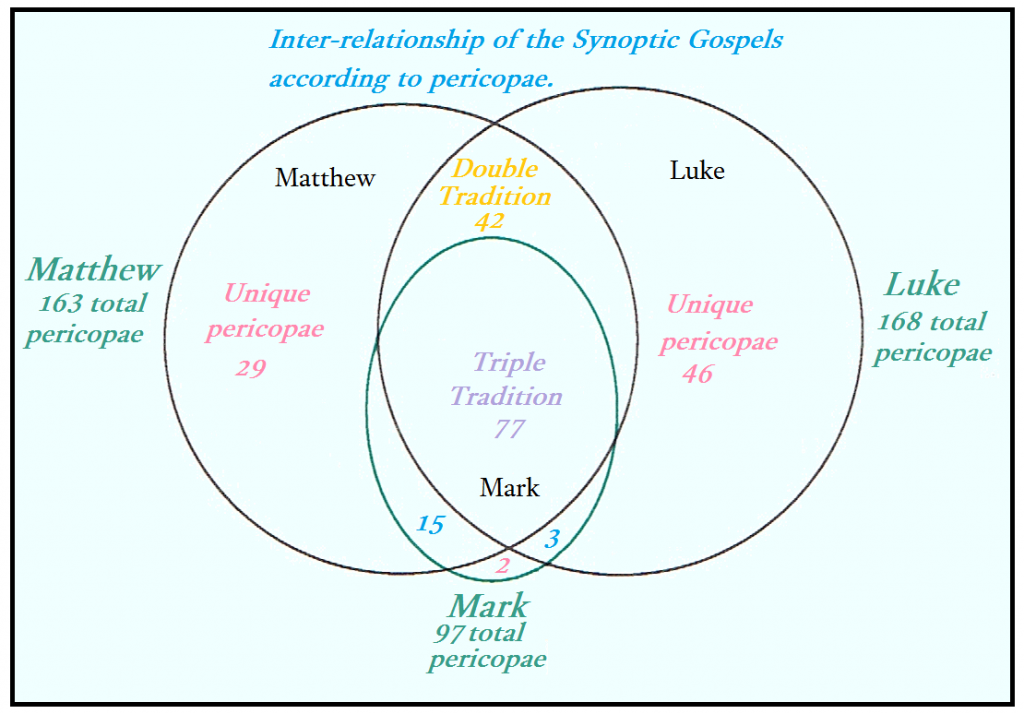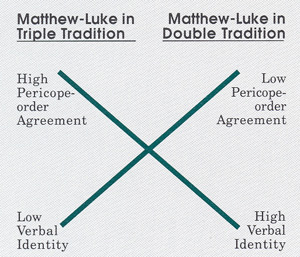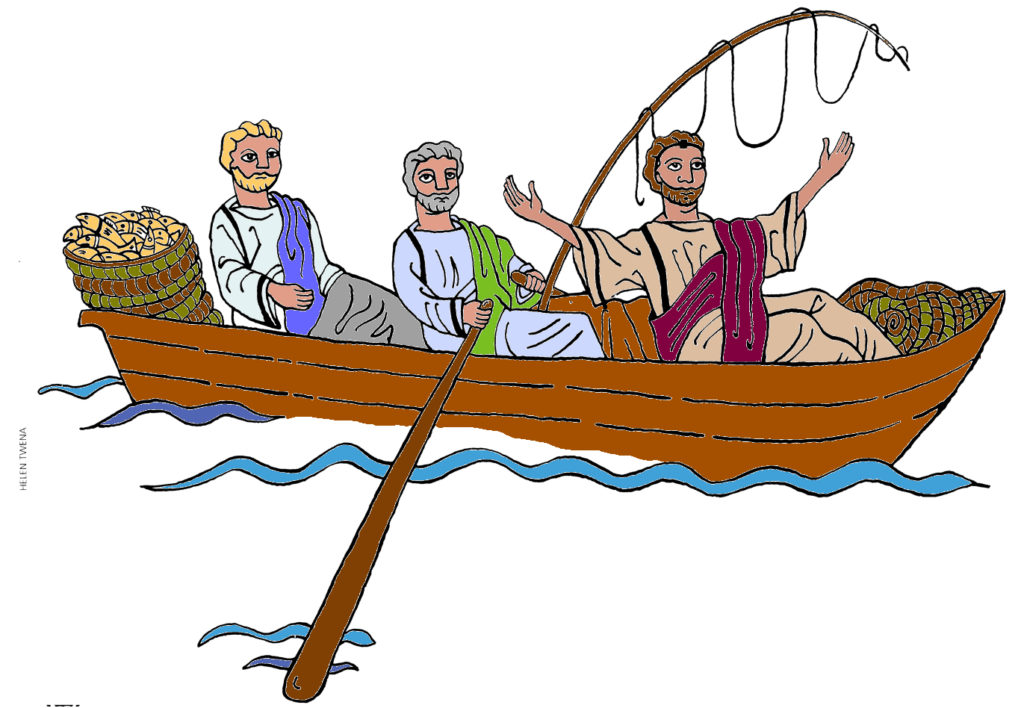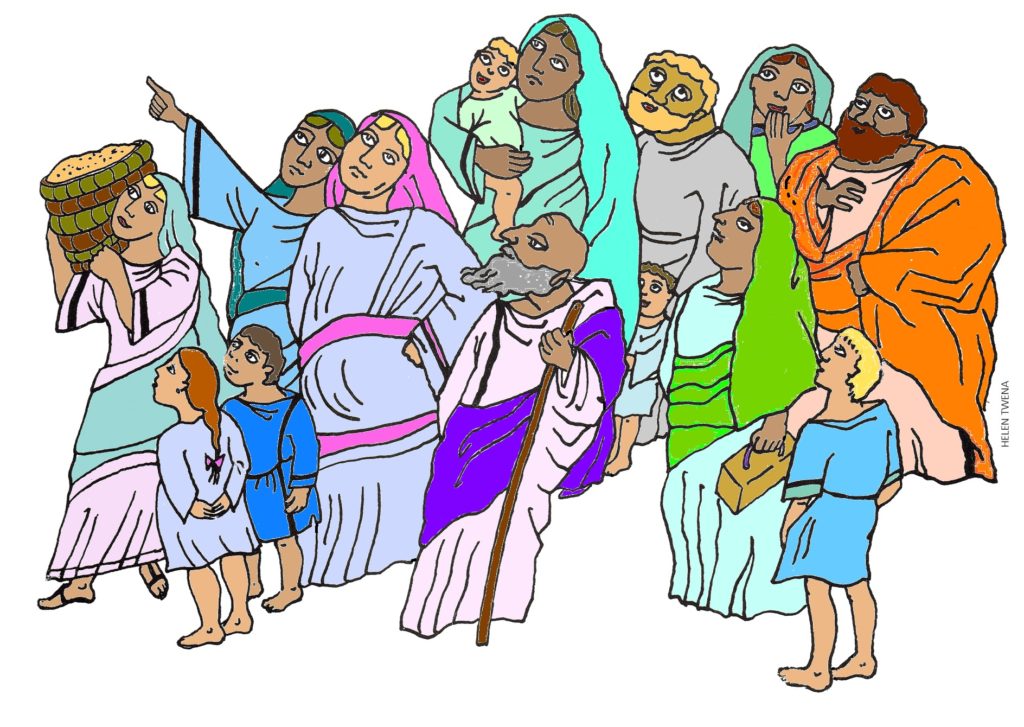|
|
In contemporary debate concerning the Synoptic Problem, the priority of Mark has been seriously challenged. While a number of solutions have been proposed, the pioneering work of Robert L. Lindsey deserves more serious consideration from the scholarly community than it has heretofore received. Moreover, in discussion of the relationship between Mark and Luke, Lindsey’s theory brings to the issue new data based on word usage which has not yet been examined or tested by the scholarly community. It is the purpose of this paper to articulate as simply and briefly as possible Lindsey’s theory and to show how some recent research further strengthens the theory.
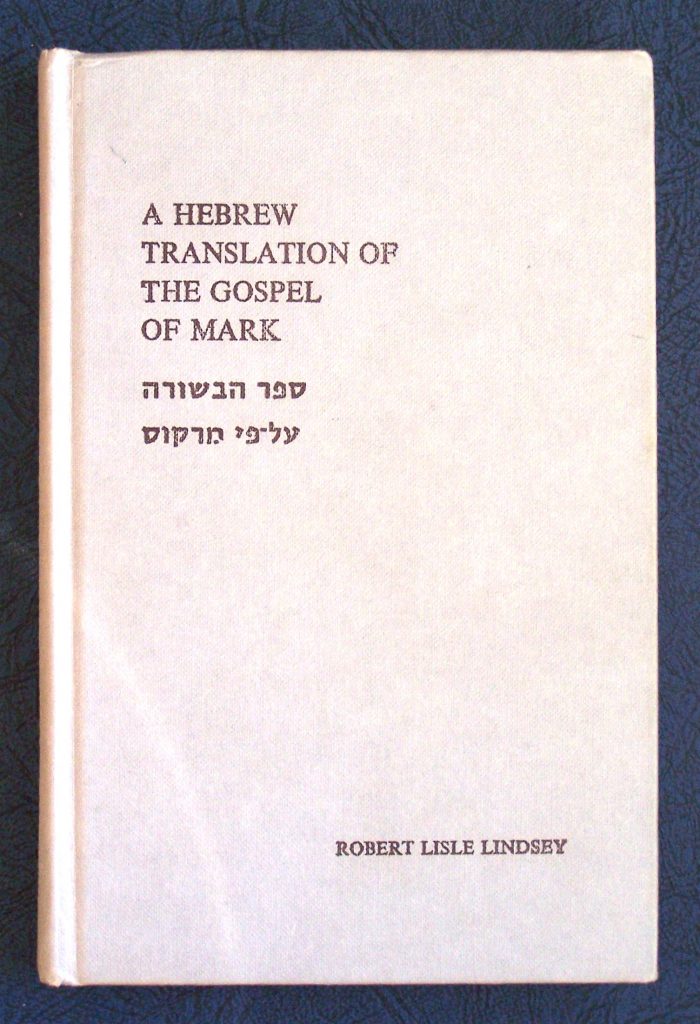
The material for this article has been drawn primarily from Lindsey’s book A Hebrew Translation of the Gospel of Mark (henceforth, HTGM).[1] In addition, I have used notes from a course on the Synoptic Problem that I took with Dr. Lindsey and have referred to his article in Novum Testamentum.[2]
The three constituent elements of Lindey’s theory of the priority of Luke cannot be understood in isolation from each other and are treated in this article under separate headings only for the sake of clarity of presentation. Accordingly, we shall first present Lindsey’s critique of Markan priority; secondly, his arguments for the priority of Luke; and finally, his theory that Luke was primarily using a literal Greek translation of an even more ancient Hebrew gospel that antedated any of our canonical gospels.
Critique of Markan Priority
Lindsey’s critique of Markan priority begins with the kind of data with which all New Testament scholars are familiar. According to Huck-Lietzmann, Synopsis of the First Three Gospels (1950), Matthew, Mark, and Luke share about 77 pericopae and place 60 of these in the same order. Of the remaining 19 stories in the Triple Tradition, Matthew-Mark agree in the placement of 9, Mark-Luke agree to place 8 in their common order, while Matthew-Luke do not agree against Mark.
In other words, there is a great measure of agreement in the placing of Mt-Mk-Lk pericopae.
Lindsey, HTGM, 19.
Lindsey makes equally conventional observations about the 42 pericopae in the Double Tradition, that is, stories not found in Mark, but usually believed to be derived from Q. These pericopae are distributed in the Markan framework but almost never in the same place. The seeming lack of order in the insertion of these 42 pericopae by Matthew and Luke into their outlines suggests strongly that Matthew and Luke are working independently. It also clearly suggests that the order of Mark has had something to do with the order in Matthew and Luke in Markan contexts.
As we have seen it is without doubt of major significance that the Triple Tradition shows us that where Mark is present Matthew and Luke largely agree on pericopae order. The Double Tradition shows us that Matthew and Luke have not been influenced by each other in the matter of story-order.
Lindsey, HTGM, 20.
While most of the above data is familiar to those who work with the Synoptic Problem, Lindsey raises a point that is seldom noticed or mentioned in discussions of Markan priority.
Now from such evidence we would expect a great deal of verbal similarity between Matthew and Luke in the Triple Tradition and much less in the Double Tradition. Just the opposite, however, is true. In the first group Matthew and Luke are rarely identical in wording for more than a few words or phrase units. In the second group Matthew and Luke show such a high verbal identity in about two-thirds of the common verses that we have to suppose one author is copying from the other or both are copying with great fidelity from some common document like the hypothetical Q.
Ibid.
This important observation can be summarized in the following two sentences. While the Triple Tradition shows close agreement between Matthew and Luke in the order of pericopae, it shows low agreement in verbal identity. While the Double Tradition shows little agreement between Matthew and Luke in the order of pericopae, it shows high agreement in verbal identity.
Lindsey’s claim that there is low agreement in verbal identity between Matthew and Luke in the Triple Tradition seems to be contradicted by the pioneering computer studies of J. Arthur Baird.[3] However, closer analysis shows that they are not basing their research on the same pericope divisions or gathering their data in the same manner. Instead of looking at complete pericopae, Baird isolated and numbered the sayings of Jesus in dependence on the form-critical work of R. Bultmann. In dealing with the words composing each logion or saying, Baird found that “The most useful form of computer print-out was an index of all words in the text arranged alphabetically each time they occurred, with tag-data listed in parallel columns after each word.”[4]
Without benefit of a computer, Lindsey has laboriously counted the total number of words in a given pericope (according to Huck-Lietzmann’s Synopsis) and compared that with the total number of words in common between two and/or three gospels. Then he observed whether Matthew and Luke were “identical in wording for more than a few words or phrase units.” Unfortunately, the computer was not programmed to make the latter observations.
Another recent study sheds additional light on Lindsey’s observation about identical “wording for more than a few words or phrase units.” In a recent article, George Howard points out how two parallel accounts may be written in inverted order.[5] For example, the word order in the sentence in the parallel account in Mark 1:42 and Luke 5:13 has been inverted. A literal translation illustrates the point. Mark has “and immediately left him the leprosy.” Luke has “and immediately (different word) the leprosy left him.” These inversions, which the computer was not programmed to pick up, contribute to the phenomenon that Lindsey is describing. Moreover, inversions are only one example of what Lindsey is describing. Matthew and Luke frequently replace a Markan term with one of their own. The result is that in the Triple Tradition “Matthew and Luke are rarely identical in wording for more than a few words or phrase units.” However, when Matthew and Luke copy Q, they can write the same words in a given sequence for several sentences.
We are now ready to understand an observation that Lindsey has called the Markan Cross-Factor. This is a major point in his critique of Markan Priority, best described in his own words:
It has four elements, all of which must be explained in any adequate Synoptic theory. Let us indicate the observation in the following way:
The reason we use the expression Cross-Factor is evident. The reason for calling the Cross-Factor Markan is of course due to the fact that it is only the presence of Mark which distinguishes the Triple Tradition from the Double Tradition. It is obvious that the Gospel of Mark is somehow responsible for the particular pattern the evidence takes and the only question is how.
Lindsey, HTGM, 21.
In the problem of distant and close wording, the Markan Cross-Factor bares an unexpected weakness in the argument for Markan Priority. Why do Matthew and Luke treat Mark’s pericopae order with great respect, but his wording with little respect? Actually, the problem is more serious than the above question indicates if the percentage of words-in-common between Matthew-Mark and between Mark-Luke is computed! Verbal identity between Matthew and Mark in parallel varies considerably but averages about 75%, while verbal identity between Mark and Luke in parallel averages about 50%. The reply of Markan Priorists may be that since Matthew and Luke are using their sources independently, it simply happens that Matthew treats Mark with more respect than Luke.
But, if this is so, how does it happen that the use of Mark separates the wording of Matthew and Luke from each other so dramatically that in Triple Tradition contexts their difference in verbal identity in the same parallel story (and often sentence) is often as high as 60%? It is, on the other hand, perfectly clear that Matthew and Luke are capable of copying a non-Markan passage word by word for many sentences, for we often see this in the Double Tradition.
Lindsey, HTGM, 22.
For those who hold that Matthew and Luke independently use Mark and Q, there are only two “reasonable” answers to the questions formulated in the (above) paragraph:
…either (1) Matthew and Luke have independently come to the remarkable conclusion that (a) Mark’s pericopae-order is excellent, (b) Q’s pericopae-order is poor, (c) Mark’s wording is bad, and (d) Q’s wording is often splendid, or, (2) Matthew and Luke have some mechanical reason, such as a better parallel text to Mark, for diverging verbally from each other in Markan context.
Lindsey, HTGM, 22.
If the first answer above “taxes the credibility” of students of ancient texts, the second answer raises the possibility of the presence of a “better parallel text to Mark,” a possibility further strengthened by Lindsey’s other argument against Markan Priority, concerning the so-called Minor Agreements against Mark. However, before turning to the Minor Agreements, another objection to Lindsey’s formulation of the Markan Cross-Factor should be addressed. Should not higher verbal identity be expected in copying Q material, since Q material consists primarily of “sayings,” whereas Mark consists primarily of narrative material? While the answer may seem self-evident, a recent study by David Peabody[6] examines the kinds of changes made by Matthew and Luke in the Markan prophetic sayings found in 9:1, 13:20, and 14:25. The changes are like the Minor Agreements of Matthew and Luke against Mark found in Markan narratives. Thus, advocates of Markan Priority would have to argue that Matthew and Luke not only do not copy Markan narratives as accurately as they copy Q sayings, but also the later evangelists do not copy Markan sayings as accurately as they copy Q sayings.
The Minor Agreements have been a factor in discussions of the Synoptic Problem for many years and may be defined as
a whole series of small ‘contacts’ or word and phrase agreements common to Matthew and Luke but not found in Mark in parallel stories contained in all three of the Synoptic gospels.
Lindsey, HTGM, 14.
However, as in his discussion of the Markan Cross-Factor, Lindsey makes an observation that adds a whole new dimension to the discussion. While B. H. Streeter tended to see isolated words here and there, Lindsey insists that the description of agreements must also include (1) common omissions of Markan words and phrases, (2) common use of synonyms against Markan words of different meaning in common contexts, and (3) common agreements in small word or phrase order against Mark.
A good example of the first is found in Mark 9:14-29 and parallels. Here the common omissions of Markan words and phrases provide what is perhaps the most striking observation to be made about the pericope. The blank spaces in Matthew and Luke illustrate the extent of the common omissions. A word count drives the point home. Matthew tells the story in 102 words, Luke in 124, but Mark in 270! Probably there is more common omission of Markan words and phrases here than in any other pericope in the gospels.
However, what really puzzles the interpreter is how Matthew and Luke know what to omit and what to include in their telling of the story. How do they so consistently agree with each other? Streeter would point to considerations of style and excess verbiage. But note how (according to most interpreters) they manage to omit the crux of the Markan narrative; namely, the question of faith in verses 23-24 of Mark. They also have an instinct for higher criticism for they omit everything that causes critics difficulties; namely, the second description of the sickness in verse 21, the second surging forward of the crowd in verse 25, the troublesome reference to the dumb spirit in verse 17 and the dumb and deaf spirit in verse 25. Also, both severely shorten the second of the two stories Mark has supposedly fused together in this narrative. They not only shorten the story, omit the Markan emphasis on faith, but also eliminate the problems that higher critics have found here. And all of this independently of each other!
A good example of the second element in Lindsey’s expanded list, that is, the common use of synonyms against Markan words of different meaning in common contexts, is found in parallels to Mark 9:27. There Matthew uses the term etherapeuthe and Luke uses iasato against Mark’s “took him by the hand and lifted him up.” Opposite Mark 9:17, Matthew has anthropos and Luke aner. Mark speaks of “one from the crowd.”
The importance of the so-called Minor Agreements for Lindsey’s theory may now be illustrated by the opening verse of the story of the paralytic in Mark 2:3 and parallels, where Lindsey translates the Greek texts literally as follows, for the sake of comparison:
| Matthew 9:2 | Mark 2:3 | Luke 5:18 |
| and behold | and | and behold |
| they are coming | ||
| bringing | bearing | men bearing |
| to him | to him | |
| a paralytic | a paralytic | |
| on a bed | on a bed | |
| cast | carried by four | a man who was paralyzed |
The agreement of Mt-Lk against Mark (“behold” and “on a bed”) is clear. These two-word and phrase agreements are typical, and together with hundreds of other such agreements they enable Lindsey to make the following observations:
The Minor Agreements help to clarify the strong dependence of Luke on a non-Markan text.
Lindsey, HTGM, 17-18.
The Minor Agreements help us to clarify the nature of the early narrative which apparently lies behind all the Synoptic Gospels. This proto-narrative is certainly best seen in Luke but can be partially seen in Matthew in his Minor Agreements with Luke in Markan contexts and may appear in Matthew’s highly Hebraic texts which are consistently found in non-Markan contexts. This under-text shows some signs of annotation and editing by a Greek writer but apparently preserves within it a highly literal Greek translation of a Hebrew original.
The significance of the Markan Cross-Factor and of the Minor Agreements in Lindsey’s critique of Markan priority have been shown. Both elements of the critique point to a non-Markan text on which Luke and Matthew drew. However, before presenting the arguments for Lukan priority, it will be helpful at this point to diagram Lindsey’s theory in order that the argument in the next two sections of the paper may be grasped more easily.
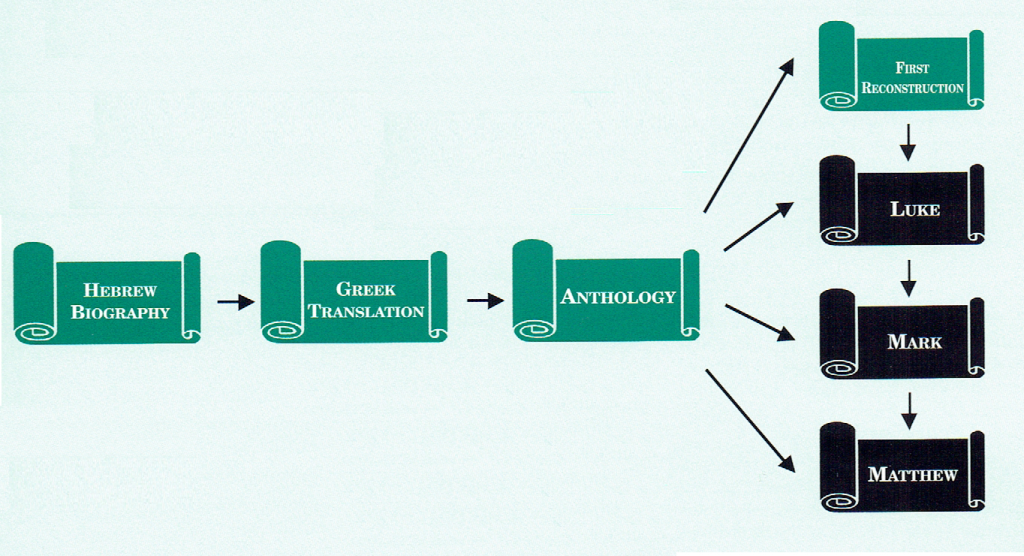
The Priority of Luke
Having seen Lindsey’s critique of Markan priority, we are now ready to consider his reasons for holding the priority of Luke. Actually his reasons are both direct and indirect. The direct reason for holding Lukan priority is the peculiar vocabulary relationship that exists beween Mark and Luke. The indirect reason is found in Lindsey’s rejection of the hypotheses, in recent and ancient formulations respectively, of Griesbach and Augustine.
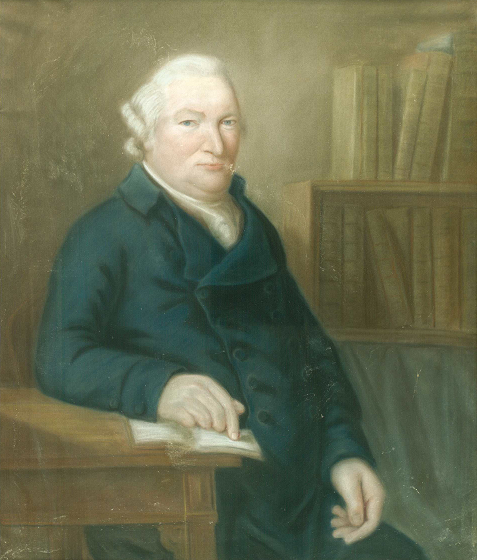
J. J. Griesbach suggested that Luke had used Matthew in writing his gospel and then Mark combined both Matthew and Luke sometime later. As was the case with Markan priority, so is the case with this theory. As soon as the Markan Cross-Factor is applied, immediate difficulties appear, the chief problem being the attempt to make Luke dependent on Matthew before Mark uses both of them.
Luke must look at Matthew and decide to treat the Triple Tradition material completely differently than the Double Tradition, yet he does not have Mark to help him know where the Triple Tradition is yet to be! Even if we grant that Luke has decided for some unexplained reason to treat part of his material from Matthew as worthy of careful word-copying yet almost never to be put where Matthew puts it and to treat another great part of Matthew as if the order is usually good but the wording mainly unacceptable we have to imagine Mark managing to record only those portions in Matthew and Luke which are verbally distant. By what streak of genius did Mark succeed in avoiding all those word-by-word parallels of the Double Tradition? To ask the question is to point up again the central fact that somehow the presence of Mark has produced the Markan Cross-Factor and the probability is that Mark must precede at least one of the other two Synoptists in any solution which is to meet all the conditions.
Lindsey, HTGM, 23-24.

According to St. Augustine, Mark used Matthew, and Luke used both Matthew and Mark in writing his gospel. In terms of the Markan Cross-Factor, Augustine fares better than does Griesbach since chronologically Mark is placed between Matthew and Luke. The major flaw in the argument is the failure to explain Luke’s treatment of the Matthaean order of pericopae in the Double Tradition. Why did Luke so persistently refuse to place the Double Tradition where Matthew did? As Streeter pointed out, Luke places his Double Tradition pericopae in blocks, while Matthew often scatters bits and parts of this material in contexts which appear to be far less original than those of Luke.
How did Luke manage, for instance, to pick out Mt 24.26,27, 24.37-41, 10.39, 24.40, and 24.28 and give them in the remarkable form they occupy in Luke 17.22-37? Or how can one say that Luke has built…Lk 15.1-10 out of the fragment in Mt 18.12-14? … At this point the Markan Priority supposition that Matthew and Luke have a common non-canonical source remains the most adequate explanation.
Lindsey, HTGM, 24-25.
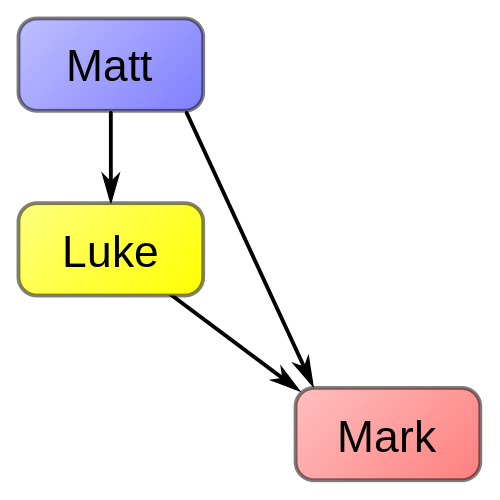
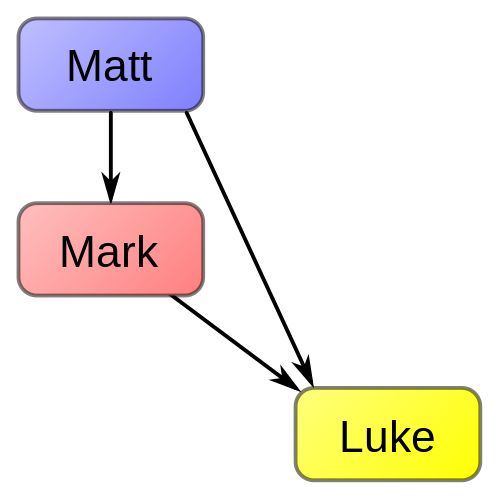
Thus on the one hand, Lindsey rejects Griesbach’s hypothesis because Mark seems to stand between Matthew and Luke; and on the other hand, he rejects Augustine’s hypothesis because Matthew and Luke did not seem to know each other. Let us now turn to Lindsey’s positive reason for positing the priority of Luke.
A careful analysis of Markan stereotypes, that is, certain words and expressions that Mark repeatedly uses, demonstrates a peculiar relationship between the two gospels. For example, one Markan stereotype is the use of kai elegen/elegon “and he was saying, they were saying.” According to Moulton-Geden, there are about 48 usages for elegen/elegon in Mark, 11 in Matthew, and 21 in Luke. Considering the respective lengths of the gospels, Mark uses the expression about five times as often as Luke and nine times as often as Matthew. Now add to this the use of Mark’s favorite historical-present legei/legousin, “he is saying, they are saying.” Luke uses legei four times, but Mark uses legei/legousin 67 times and Matthew 36 times. Thus, Mark uses the expressions legei/legousin and elegen/elegon about 115 times. While Luke is not opposed to either usage (he uses both a total of 26 times), the two writers manage to “get together” in parallel usage of these terms only twice out of 141 instances!
In view of the sentence-by-sentence parallelism existing between Mark and Luke for over three hundred common verses the only possible explanation of this disparate use of the above terms is that one of the writers is deliberately avoiding the usages when he sees the other writer employing them.
Lindsey, HTGM, 29-30.
The supposition that one of the writers is deliberately avoiding the usages of the other is confirmed by examining the radically different placement of the approximately 100 Mk-Lk words not used in Matthew with the placement of the approximately 160 Mt-Mk words not used in Luke. Eighty percent of the Mt-Mk words appear in immediate Markan-Matthaean parallels. Over 50 percent of the Mk-Lk words appear in disparate contexts.
This means that Luke’s use of the given word will appear very often in a non-Markan context or story but the Markan use of the word will stand in place of a quite different word in the immediate Lukan parallel.
Lindsey, HTGM, 51.
A specific example of this strange vocabulary relationship, which occurs in the pericope of the Feeding of the Five Thousand, was called to my attention by Dr. Lindsey.[7]
Note Mark’s use of apēggeilan (Mark 6:30) opposite Luke”s diēgēsanto (Luke 9:10). Mark and Luke, except for one reference in Hebrews, are the only New Testament writers to use diēgeomai. The phrase diēgēsato autois pōs is found both in Acts 9:27 and 12:17. This same phrase occurs in Mark 5:16 opposite Luke’s apēggeilan autois pōs in Luke 8:36. Now to strengthen this evidence of oddity. A few verses later Luke writes diēgou hōsa, and here Mark writes apaggeilon autois hōsa (Luke 9:39/Mark 5:19). In other words, opposite the two appearances of diēgeomai in Luke, Mark has apaggellō; and opposite one appearance of apaggellō in Luke 8:36 Mark has diēgeomai! The oddity in summary: Luke 8:36 has in Mark 5:16 a synonymic usage that is also found in Acts 9:27 and 12:17. Luke 8:39 and Mark 5:19 reverse this phenomenon. Luke 9:10 and Mark 6:30 show the reversing of this phenomenon again. Put most simply, we have two writers, one of whom is using the other and quite deliberately changing the word he sees in the text he is copying by reference to a distant context in which there is a synonymic parallel.
Since the recognition of these strange vocabulary relationships brings new data to bear on the synoptic problem, it is appropriate to consider the unexpected vocabulary linkage between Mark and Acts. Again, I discovered the following examples from the Feeding of the Five Thousand. In 6:31, Mark uses eukaireō which is found only in Acts 17:21 and 1 Corinthians 16:12. The combination of ērchato and didaskein, which Mark alone uses among the gospel writers, is found again in Acts 1:1. In Mark 6:33 suntrechō occurs, found again in a similar context in Acts 3:11 and then only in 1 Peter 4:4 in the rest of the New Testament. The combination of hoi apostoloi with sunagomai in Mark 6:30 is found again in Acts 15:6. Also, proēlthon in Mark 6:33 (which term occurs twice in Mark and twice in Luke) is found four times in Acts. Epigignōskō, which is found in Mark 6:33 and in three other places in Mark, is a favorite term in Acts.
The above examples are representative of a large corpus of vocabulary data that Lindsey has collected. Does this new data prove the priority of Luke? Could it not equally indicate the priority of Mark? At least four points indicate that Mark is responsible for this strange vocabulary relationship.
First, we note how the evidence forces the adherent of Markan Priority to suppose that Luke has deliberately rejected large numbers of words and expressions as he copied Mark in his Markan contexts, only to return to just these rejected usages as he writes the non-Markan portions of his gospel or records the quite different historical material in Acts. This method of handling Markan material is then abandoned when Luke turns to the Double Tradition material.
Secondly, if Mark is following Luke and rejecting specific Lukan words in favor of synonymic parallels that he finds elsewhere in Luke/Acts and in Paul, he would be using words in the same way as a person who is familiar with the Midrash and other rabbinic literature.[8]
For Mark, who does indeed look like a writer well acquainted with rabbinic methods of word-play, one text is as good as another and can be used to illuminate the immediate text before him.
Lindsey, HTGM, 41.
Thirdly, an even more cogent argument that Mark is changing Luke is given by the Markan Cross-Factor, which demands a serious explanation for the wide gap in verbal identity between our Gospels where all three are in parallel. The explanation seems to be that Mark is in the middle causing this verbal gap.
Now the moment we recognize the double fact that Mark is deliberately and radically changing the exact wording of his sources, including Luke, and that Matthew, despite his dependence on the other parallel texts, is greatly influenced by Mark, we obviously have an explanation of the method by which Mark has caused the Matthaean-Lukan verbal distance in the Triple Tradition.
Ibid. (Emphasis original.)
Fourthly, Lindsey’s findings concerning Mark’s method of writing are quite in harmony with the insights of those who have studied Markan redaction. Lindsey himself has given us a fascinating study of Mark’s redactional techniques in his article in Novum Testamentum, where the Lukan parallels to the little Apocalypse in Mark 13 are isolated and studied.
With the arguments for the priority of Luke set forth above, there remains only to examine the part of Lindsey’s hypothesis most difficult to prove, that is the conviction that Luke was copying from a literal Greek translation of an ancient Hebrew gospel.
An Ancient Hebrew Gospel
Any description of Robert L. Lindsey’s unique theory of gospel relationships should include the fact that he started his work as a translator of the gospels into modern idiomatic Hebrew. In translating Mark’s gospel, he found many phrases and expressions which could not be turned into Hebrew without idiomatic distortion. These “non-Hebraisms,” as Lindsey calls them, sometimes appear in the text with great frequency. Lindsey began to suspect that the writer was using a Greek text which had itself been translated quite literally from a Semitic original, but which had been thoroughly edited by the insertion of words and phrases which were more Greek than Semitic. He came to see these “non-Hebraisms” as the result of the redactional activity of Mark.
The story was quite different when Lindsey turned his attention to Luke. Here he found a Greek text which normally translates easily to Hebrew and which almost always is lacking in those “non-Hebraisms” which make translation into idiomatic Hebrew so difficult in Mark.
The strong Hebrew-styled story we see so constantly in Lk, and often in Mt, is, like all Hebrew narrative, not given to picturesque redundancy and dramatization. It is straight-forward and concise, emphasizing the verb and noun, nouns in construct, prepositional phrases, etc., but rarely adverbs, adjectives, or other constructions which introduce psychological descriptions of persons or events.
Lindsey, HTGM, 61.
Again, in translating Mark into Hebrew, Lindsey found significant data which shaped his theory. He found that where Matthew was parallel to Mark and Luke, many of the Markan translation difficulties reappeared. However, where Matthew was not parallel to Mark, as in the Double Tradition or in the material peculiar to Matthew, the Matthaean text showed the same ease of translation into Hebrew as did the text of Luke.
In describing early insights that arose out of his translation activities, Lindsey writes the following:
It looked as if Luke had universally copied more faithfully whatever Greek sources he had and that these had been translated earlier from a Hebrew source or sources, or at least from some Semitic document or documents so much like Hebrew that in re-translation it was impossible to tell the difference. It also looked as if Matthew had indeed used Mark’s Gospel with all its redactic expressions, but had rejected many of these for some reason I could not yet explain.
Lindsey, HTGM, 12-13.
While it is tempting to include samples of Lindsey’s translation work at this point, it would do little to facilitate understanding or acceptance of the theory. Most scholars simply have not had enough training in the comparative use of Greek and Hebrew to evaluate this part of his theory. How then can the scholarly community enter into the thorough testing of the data? Such a testing will not be easy. Rather, as David Flusser points out in his introduction to Lindsey’s book, the theory can be tested only when two conditions are fulfilled. First, the investigator must study most of the relevant gospel material in the light of the theory. Secondly, he or she must know enough Greek, Hebrew, and Aramaic to understand the argument.
In my own work with the theory, I have focused on the peculiar vocabulary relationship between Mark and Luke/Acts. Lindsey’s word-studies open a whole new chapter in Synoptic research. In his suggestion that Mark uses words like a darshan (writer of Midrash), I think Lindsey provides us a key to Mark’s redactive methods. Also, Lindsey’s articulation of the Markan Cross-Factor is a definite contribution to Synoptic criticism.
- [1] Robert Lisle Lindsey, A Hebrew Translation of the Gospel of Mark (Jerusalem: Dugith, 1973). [The pertinent section of this book has been reissued on Jerusalem Perspective as “Introduction to A Hebrew Translation of the Gospel of Mark”—JP.] ↩
- [2] Robert Lisle Lindsey, “A Modified Two-Document Theory of the Synoptic Dependence and Interdependence,” Novum Testamentum 4 (1963) 239-263. This article reflects an earlier stage of Lindsey’s investigations than that found in his book. [Lindsey’s Novum Testamentum article has been reissued on Jerusalem Perspective as “A New Two-source Solution to the Synoptic Problem”—JP.] ↩
- [3] J. Arthur Baird, Audience Criticism and the Historical Jesus (Philadelphia: Westminster, 1969). See also his “Content Analysis and the Computer: a Case-Study in the Application of the Scientific Method to Biblical Research,” Journal of Biblical Literature 95 (1976): 255-276. ↩
- [4] Baird, “Content Analysis,” 261. ↩
- [5] George Howard, “Stylistic Inversion and the Synoptic Tradition,” Journal of Biblical Literature 97 (1978): 375-389. ↩
- [6] David Peabody, “A Pre-Markan Prophetic Sayings Tradition and the Synoptic Problem,” Journal of Biblical Literature 97 (1978): 391-409. ↩
- [7] W. R. Stegner, “Lucan Priority in the Feeding of the Five Thousand,” Biblical Research 21 (1976): 19-28. ↩
- [8] Further evidence that Mark is using Luke-Acts is suggested by the location in redactional passages of the words that Mark shares with Acts. See my article cited above. ↩

